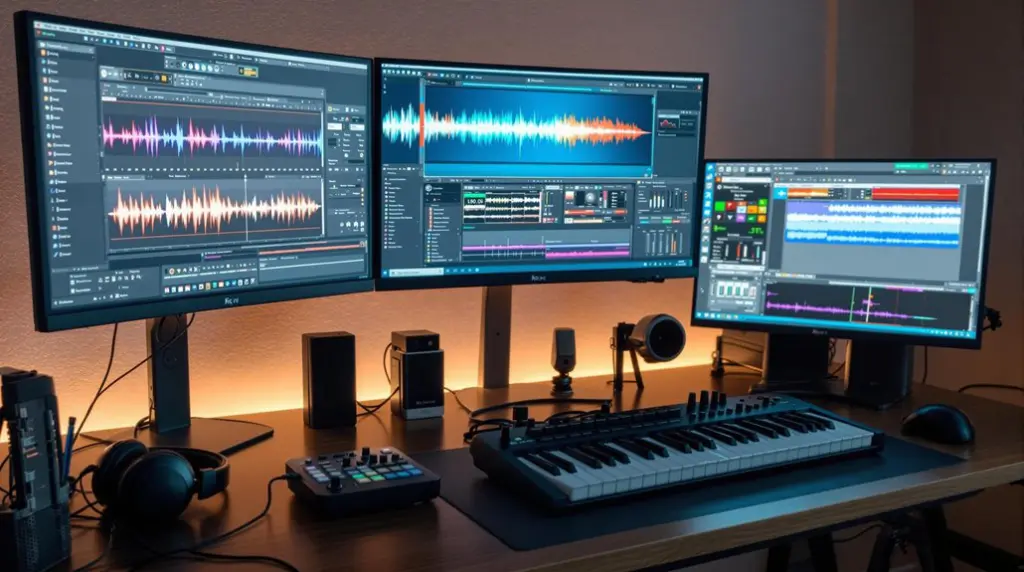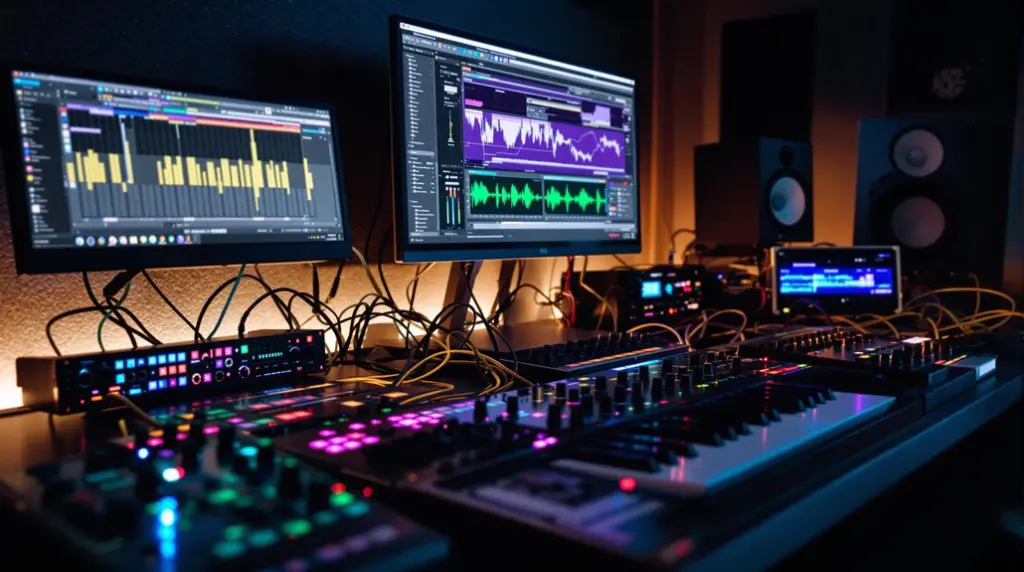The Arturia Filter M12 VST Plugin excels with three key features: advanced modulation capabilities, flexible filter configurations, and a user-friendly interface. The modulation matrix allows assignment of sources to over 20 destinations, enhancing musical expressiveness with programmable envelopes and random value generators. Its dual discrete analog filters support 15 modes and four routing options, providing extensive sound customization with low-latency performance. The resizable GUI, intuitive navigation, and extensive MIDI mapping capabilities streamline workflow and real-time control. These features make the Filter M12 a powerful tool for professional sound design and music production, with more impressive capabilities to explore.
Key Takeaways
- Modulation matrix assigns sources to over 20 destinations for versatile sound shaping.
- Dual analog filters with independent control offer 15 modes for diverse sonic textures.
- Resizable GUI enhances workflow efficiency and visual engagement.
- Extensive MIDI mapping allows for real-time control during live performances.
- Built-in tutorials and real-time explanations aid user learning and mastery.
Advanced Modulation Capabilities
Consistently revered for its versatility, the Arturia Filter M12 VST plugin’s Advanced Modulation Capabilities stand out as a pivotal feature for sound designers and musicians. At the heart of this functionality is the thorough modulation matrix, which facilitates the assignment of modulation sources to over 20 destinations. This allows for dynamic sound shaping, giving users the ability to craft intricate and evolving soundscapes.
The programmable modulation envelopes embedded within the plugin greatly enhance the expressiveness of musical elements. These envelopes can be meticulously tailored to evolve sounds over time, providing a rich and immersive audio experience. Additionally, the inclusion of random value generators within the modulation matrix introduces an element of unpredictability. This feature enables users to infuse their sound design with unique variations, adding a layer of complexity and originality to their work.
Furthermore, the Filter M12’s dual discrete analog filters offer a playground for creating complex modulation scenarios. By leveraging these filters, users can develop sophisticated sound textures and rhythmic patterns that are both intricate and dynamic. This robust modulation framework, consequently, empowers users to achieve expressive modulation, resulting in dynamic soundscapes that are both innovative and enthralling.
Flexible Filter Configurations
Building on the robust modulation framework, the Arturia Filter M12 VST plugin further distinguishes itself with its Flexible Filter Configurations. This plugin offers four distinct filter routing options—A, B, series, and parallel—providing users with a versatile toolkit for sound customization. Each routing configuration allows for unique signal paths, greatly broadening the palette of achievable sounds.
The M12’s dual analog filters are independently controllable, with adjustable cutoff and resonance parameters. This level of independent control facilitates intricate sound shaping, enabling users to sculpt their audio with precision. The plugin supports 15 different filter modes, including Low Pass, High Pass, and Notch filters, delivering an extensive range of tonal possibilities. Proper EQ settings guarantee that these filter modes can complement rather than overpower other elements in a mix, preventing muddiness and enhancing clarity.
Arturia’s inclusion of a modulation matrix further enhances the potential for complex modulation effects. Users can route over 20 configurable destinations for both filters, allowing for advanced sound design techniques that can be tailored to specific needs.
Despite its extensive capabilities, the M12’s design is CPU-friendly, guaranteeing low-latency performance. This makes it an excellent choice for both studio production and live settings, where seamless integration and performance reliability are paramount.
Altogether, these features make the Arturia Filter M12 a powerful tool for sound customization.
User-Friendly Interface and Control
The Arturia Filter M12 VST plugin excels in providing a user-friendly interface and control mechanisms that streamline the sound design process. The resizable GUI allows users to adjust the interface to fit their screen space preferences, enhancing visual immersion and optimizing workflow efficiency. This flexibility is complemented by intuitive navigation, which enables users to access controls and modulation options effortlessly, thereby minimizing the time spent on configuring settings.
Additionally, removing unwanted frequencies can be easily managed within the plugin, ensuring clarity and precision in sound design.
Real-time control is another significant feature, facilitated through extensive MIDI mapping capabilities. This allows for instant hands-on manipulation of mix parameters, making it particularly useful during live performances and dynamic music production scenarios. Users can assign specific plugin functions to their MIDI controllers, ensuring a seamless interaction between hardware and software.
The streamlined preset browser further enhances usability by allowing users to organize and recall sounds with ease. Presets can be filtered by instrument type, genre, and production technique, providing quick access to desired sounds and promoting an efficient workflow.
Additionally, built-in tutorials and real-time explanations of controls within the interface aid in user comprehension, ensuring that even novice users can master the plugin and maximize its potential effectively.
Frequently Asked Questions
Does the Plugin Support MIDI Learn Functionality?
Yes, the plugin supports MIDI Learn functionality, facilitating extensive MIDI automation. This feature allows for precise filter modulation by assigning MIDI controllers to various parameters, enhancing the flexibility and expressiveness of your sound design process.
What Are the CPU Usage Requirements for Optimal Performance?
For ideal performance, the plugin requires efficient CPU optimization. Performance tips include utilizing a multi-core processor and ensuring other applications are minimized, thereby allocating maximum CPU resources to the plugin for seamless operation.
Is There a Built-In Preset Library?
Yes, the plugin includes a thorough built-in preset library, facilitating efficient preset organization. Additionally, it supports extensive user customization, allowing users to modify and save their own presets to suit specific production needs.
Can the Plugin Be Used in Standalone Mode?
The plugin cannot be used in standalone mode; it requires a host DAW for operation. However, it offers advanced audio routing capabilities within the DAW, facilitating sophisticated standalone performance configurations and seamless integration into complex audio processing chains.
What DAWS Are Compatible With the Arturia Filter M12 VST Plugin?
The current question pertains to plugin integration within various digital audio workstations (DAWs). The Arturia Filter M12 VST plugin is compatible with major DAWs including Ableton Live, Logic Pro, Cubase, FL Studio, and Pro Tools, ensuring wide-ranging digital audio support.
Conclusion
The Arturia Filter M12 VST plugin stands out due to its advanced modulation capabilities, flexible filter configurations, and user-friendly interface and control. These features collectively enhance the plugin’s versatility and functionality, making it a valuable tool for both novice and experienced users. By offering intricate sound design possibilities and ease of use, the Arturia Filter M12 solidifies its position as a robust and essential component in modern digital audio workstations.




